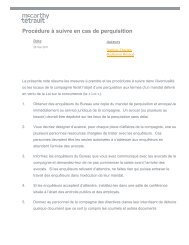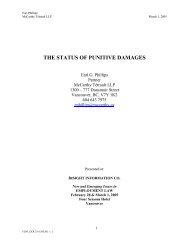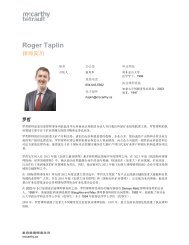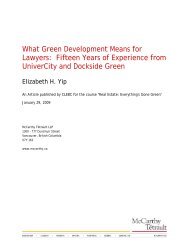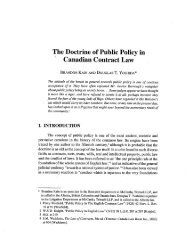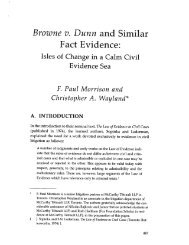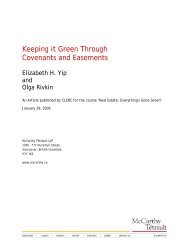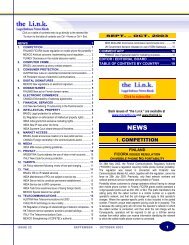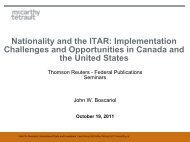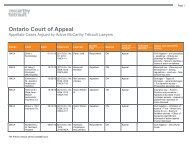Presentation Material - McCarthy Tétrault
Presentation Material - McCarthy Tétrault
Presentation Material - McCarthy Tétrault
You also want an ePaper? Increase the reach of your titles
YUMPU automatically turns print PDFs into web optimized ePapers that Google loves.
Chris Falk<br />
Stefanie Morand<br />
<strong>McCarthy</strong> Tétrault LLP<br />
treatment in the hands of the estate (although the CRA noted that capital loss carry-back<br />
planning could be undertaken to avoid double taxation). 26<br />
The CRA revisited this issue at the 2010 Canadian Tax Foundation (“CTF”) Annual Conference.<br />
While the PowerPoint questions and responses distributed by the CRA were not definitive, in<br />
the discussions the CRA seemed to suggest that subsection 84(2) would be applied to a postmortem<br />
pipeline of a corporation that held all cash.<br />
In 2011, the issue was again revisited at the STEP Conference, the British Columbia Tax<br />
Conference and the CTF Annual Conference.<br />
At the 2011 British Columbia Tax Conference, the CRA stated that “pipeline planning is not<br />
dead…but the potential application of anti-avoidance provisions of s. 84.1 and s. 84(2) must be<br />
reviewed” (emphasis original).<br />
As for “facts and circumstances” that would lead to the application of subsection 84(2), the CRA<br />
stated as follows at the 2011 CTF Annual Conference:<br />
[…] in the context of a series of transactions designed to implement a post-mortem pipeline<br />
strategy, some of the additional facts and circumstances that in our view could lead to the<br />
application of subsection 84(2) and warrant dividend treatment could include the following:<br />
• The funds or property of the original corporation would be distributed to<br />
the estate in a short time frame following the death of the testator.<br />
• The nature of the underlying assets of the original corporation would be<br />
cash and the original corporation would have no activities or business<br />
(“cash corporation”). 27<br />
At the 2011 STEP Conference and the 2011 CTF Annual Conference, the CRA recognized the<br />
potential for double taxation arising as a consequence of the deemed disposition on death but<br />
stated that the double taxation which pipeline planning is intended to address could be<br />
“avoided” or “mitigated” with the implementation of “the subsection 164(6) capital loss carryback<br />
strategy”. As discussed below, in the authors’ view, to suggest that capital loss planning is<br />
the appropriate remedy is not – from a policy perspective – a reasonable approach given the<br />
provisions of the Act, nor does it accord with the fairness concerns which underscored Mr.<br />
Justice Hershfield’s decision in MacDonald, discussed below, and the Supreme Court of<br />
Canada’s decision in Canada Trustco. 28,29<br />
26<br />
27<br />
28<br />
29<br />
CRA Document No. 2010-0389551R3, from 2010.<br />
These same “facts and circumstances” were identified at the 2011 STEP Conference and the 2011 British<br />
Columbia Tax Conference.<br />
Canada Trustco Mortgage Co. v. The Queen, 2005 DTC 5523 (SCC) [“Canada Trustco”].<br />
Subsection 164(6) requires that the loss be sustained in the estate’s first taxation year, and is subject to<br />
numerous stop-loss rules. In many circumstances (e.g., where the validity of a will is contested, underlying facts<br />
are uncertain or planners are simply not contacted in time), it may not be feasible to trigger the loss within the<br />
time allowed. Further, in some circumstances, the deceased will have sufficient loss carryforwards or tax credits<br />
to shelter the gain on death such that the subsection 164(6) loss carry-back is of no benefit to the deceased.<br />
Since the deceased’s credits cannot be carried forward to offset income in the estate (including income arising<br />
on the wind-up or redemption), significant inequities could arise if pipeline planning is not possible or if it is<br />
possible only in the limited circumstances in which CRA is prepared to rule favourably.<br />
560600/422632<br />
MT DOCS 11864055v1G<br />
7



